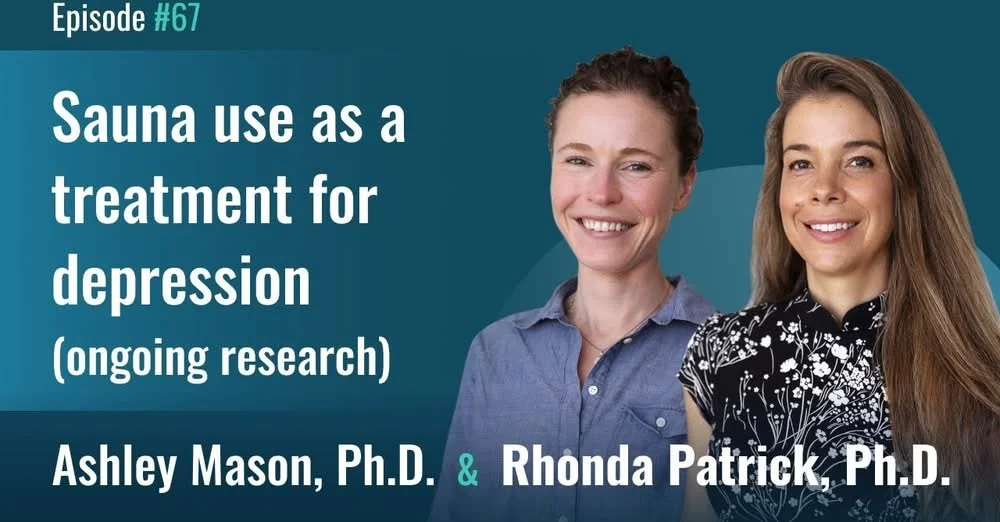Sauna bathing’s health benefits: mood
Context
This is the first in a series of posts I’ll write on the health benefits of saunas. Most people that sauna will report feeling “renewed” or “refreshed” in the immediate aftermath. This near-instant impact can turn one’s day around, or provide some relief after a hard workout. Perhaps more interesting, though, is the long-term health impacts of sauna bathing — things like reduction in cardiovascular disease, stroke events and hypertension. Here I’ll share some evidence on sauna’s potential positive impacts on mood disorders, specifically depression.
Research on mood benefits
In a chat with Dr. Rhonda Patrick, Dr. Ashley Mason, a clinical psychologist at at the Osher Center for Integrative Medicine at UCSF, discussed research on whole-body hyperthermia’s impact on major depressive disorder. The first 30 minutes of this video cover that discussion: https://www.youtube.com/watch?v=f20HNxZdGvU
The main study that Dr. Mason references was a 2016 clinical trial led by Clemens Janssen involving whole-body hyperthermia for the treatment of major depressive disorder (NIH link to study: https://pubmed.ncbi.nlm.nih.gov/27172277/) . 30 trial participants were split in half, with one group receiving whole body hyperthermia (WBH), and the other receiving a “sham” or placebo treatment that mimicked all aspects of the WBH treatment except extreme heat.
Note: It’s important to call out that “receiving whole body hyperthermia” in this case did not mean sitting in a sauna for 30 minutes. The researchers used a sort of “tent” filled with infrared lamps that enveloped a participant’s entire body excluding their head, and the participant would remain in this tent for over an hour. While there are similarities between this and dry Finnish sauna, there are a couple important differences: 1) the exclusion of the head; 2) the use of infrared radiation as opposed to dry heat; 3) the duration of exposure — staying in a dry Finnish sauna over an hour can be exceedingly difficult.
While we can’t ignore the differences between treatment in the study and a typical session in a dry Finnish sauna, the results are nonetheless amazing and should excite prospective and existing sauna users. When compared with the “sham”/placebo group, participants that received the actual WBH treatment showed significantly reduced symptoms of depression (as measured by the Hamilton Depression Rating Scale). Moreover, these results were lasting — six weeks after the end of the treatments, when the first measurement was taken, the results held up.
Sauna as cardiovascular exercise
The other thing I want to highlight in Dr. Mason and Dr. Patrick’s conversation is the notion of sauna as exercise. Lots of research has shown that regular cardiovascular exercise can be an effective treatment for major depressive disorder for some people. Good cardiovascular exercise has all sorts of benefits, but one challenge with it is that it can be inaccessible. For those with significant injuries or disabilities, figuring out a good cardiovascular exercise that’s accessible can be a real challenge. For those struggling with depression, mustering the energy to go for a run or go cycling can be quite difficult.
Sauna can, in some ways, be considered a more accessible form of cardiovascular exercise than traditional methods. While hyperthermia can feel uncomfortable, it just requires spending time in an extremely hot environment. A sauna user can sit, stand or lie down. Saunas are all-weather, climate-controlled environments, and public sauna memberships are often cheaper than most gyms.
What’s next?
As Dr. Mason points out, there is a lot more research to be done on the mood benefits (and risks) of whole body hyperthermia and how sauna can be an effective delivery vehicle. We’re still in the early innings here when it comes to understanding the long-term implications of regular sauna bathing/WBH on mood and other health factors more generally. Some of the research that’s already been done on sauna as means of driving gains in longevity and lowering chronic disease mortality will be the topic of a future newsletter.
Please let me know what you think, share this with friends if you feel moved to, and follow us on Facebook.
Also, if you live in northeast Ohio, I’d love to know when during your week you’d use a public sauna. Please let me know by filling out this form.
Thanks for reading,
Lorenzo (Tyler) Carlisle
